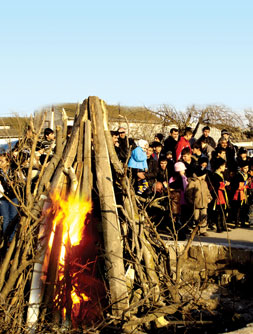 Pages 10-12
Pages 10-12by Ian Peart
and Saadat Ibrahimova
Roots
Town or country? – a familiar dichotomy in all modern civilizations, and the source of much hand-wringing as people worry about where modern society is taking us – are we losing touch with our roots etc? In Azerbaijan there is still a strong consciousness of those roots. Baku is Azerbaijan’s increasingly cosmopolitan capital - a city of some 2+ million people, nearly a quarter of the country’s population now live here. Most of the west’s familiar logos are to be found here, too: of course, McDonalds, Coca Cola and Pepsi, but also the shopping salons of Benetton, Mango, Levis and the rest. The city’s streets and squares are a veritable fashion catwalk, especially during an early summer’s evening ‘promenade’. But ask many of these fashionable strollers where they come from and many will reply with the name of a village you will struggle to find in an atlas. They may well have been born in Baku, but their roots still lie in a regional soil, and many will disappear to the country in the long summer holidays…. ….Also at Novruz Bayram. And even if spent in the city, there is still a strict tradition that it should be spent in the bosom of the family. The tradition is strongly resilient and, given the equally strong belief in hospitality, it is not difficult – even for a foreigner - to become involved.
In Amirjan
My first real experience, 9 years ago, of Novruz Bayram and of village life was just a 30 minute bus ride from the capital. I’d set off to find the statue of Sattar Bahlulzade made by the brilliant sculptor Omar Eldarov to stand over the great painter’s grave (see Visions 2:1, Winter 2007 for more on that). Walking through (you miss so much if you fl y by in a 4-wheel drive!) Bahlulzade’s home village of Amirjan I heard the sound of folk music and followed my ears to the local culture centre to find Novruz celebrations in full swing. Naturally, ever the tourist, there was a camera round my neck – the only camera present, as far as I could see – and so was immediately accosted by a strange man in rustic fustian, wearing a pointed hat and clutching a chicken; he clearly wanted me to record the event. This was, Kosa – a kind of mischievous spirit of spring. This being Azerbaijan, as a guest I first had to eat and was ushered to a privileged position - the table of the agh saghals (literally: white beards) – the village elders.I returned to the village later to deliver the photographs and have been friends with Kosa (in his other life, Culture Centre worker Namiq Hashimov) and Amirjan ever since. It is a small village with a big heart – as well as Sattar Bahlulzade it has also produced contemporary painter Gaiyur Yunus, 19th century diplomat and historian Abbasgulu Bakikhanov and early 20th century oil magnate Murtuza Mukhtarov (builder of Baku’s wonderfully gothic Wedding Palace); People’s Artist mugham singer Agakhan Abdullayev was also brought up there.
This year, however, was the first time I’d been able to return at Novruz Bayram – now with my family. The venue this time was what we would call the village green in England – at the village crossroads; Namiq was still Kosa, joined by his pal Kechel (‘Baldy’) and the agh saghals were still in pride of place. We were at a table with the obligatory samani (green sprouting wheat, symbol of new life and planting) and khoncha (a tray of sweetmeats, nuts and fruit) – food for the guest.
The fun begins
Festivities got underway in the early afternoon with the two Ks as master of ceremonies, warming up a chilly crowd and acting up in traditional style – tragic farce as Kosa thought someone had stolen his chicken and plaintive farce as Kechel joked and scrounged his way through the throng. The entertainment was all home-grown and everyone was encouraged to show off their skills. The traditional dancers were first; the girls fluent, graceful and glowing in their long dresses, the boys proud, strutting and upright in gallant black. In ancient Olympian style, sport was combined with art and represented by wrestling and cocks in unarmed combat (quite tame, no spurs, no casualties). The poets were there, too, with some feisty exponents of the Absheron speciality, meykhana (poets compete to spontaneously produce alternate verses to a strict pattern and relentless rhythm – wit is also a requirement).
Naturally, as events continued appetites grew; while children would edge towards, and sneak a bite, from the khonchas, the adults kept the lavash (thin, fl at bread) maker busy.
Fun and Freedom
Something else that struck me as the day went on was the freedom of even quite young children to wander around the arena, sometimes in and out of the performances. There was a confidence in communal care and affection that is sadly disappearing, substituted by legal regulation, in my home country.
Kosa and Kechel are not stick-in the-muds and they made sure that modern tastes were also catered for; pop singers were called up to give the youth a chance to let their hair down and dance. his became increasingly popular as the light faded and the fi re was lit – time also for people to warm themselves near the flames, reflect on the passing of the old year and revive hopes for the new one. As we wandered away from the lights and into the night, the closing darkness and spread of stars across the blackness above Amirjan were reminders of the one sky we all live under, the elements we depend on and the joys of friendship as we celebrate together the stages of our journeys through life.

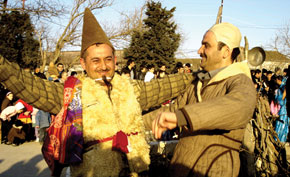
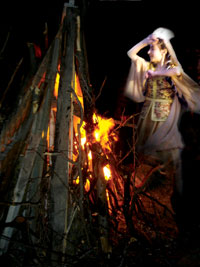
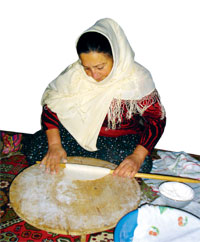
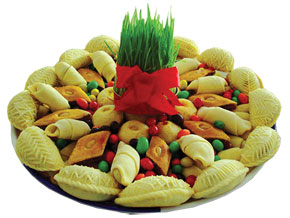


.jpg)